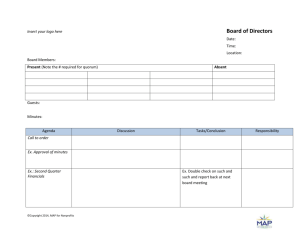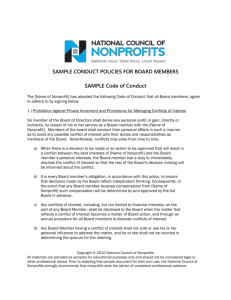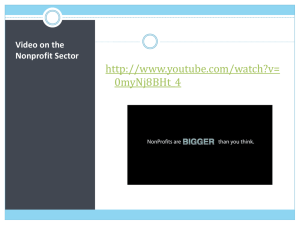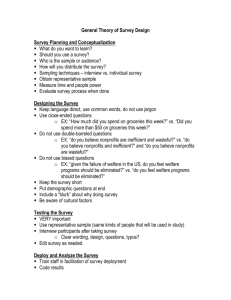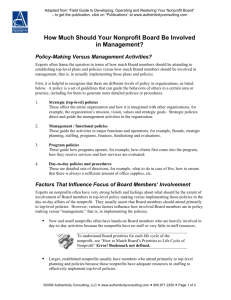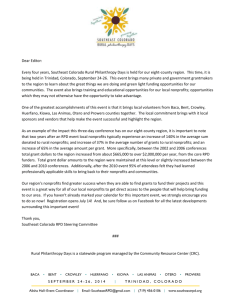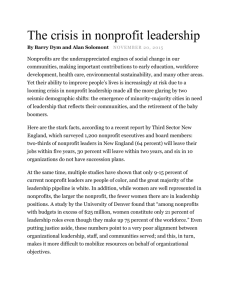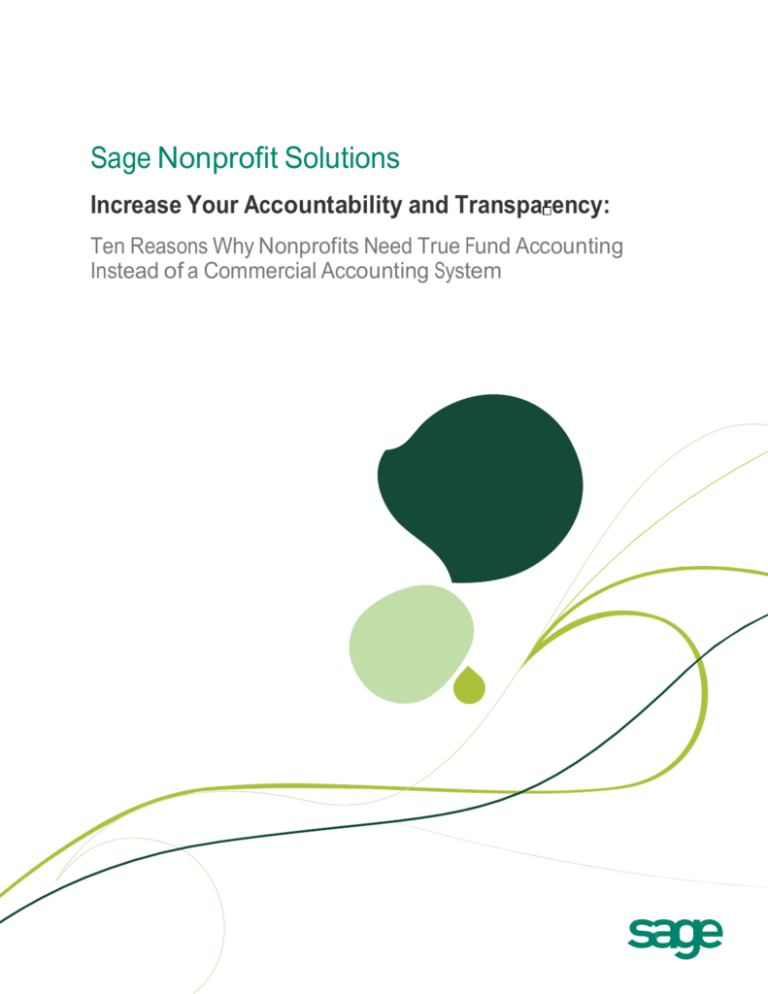
Sage Nonprofit Solutions
Increase Your Accountability and Transparency:
Ten Reasons Why Nonprofits Need True Fund Accounting
Instead of a Commercial Accounting System
Increase Your Accountability and Transparency
Introduction
In today’s world, financial management and accountability are critical for all types of
businesses and organizations. For nonprofits, the pressures are mounting. Restrictions
around the use of government grants continue to rise. Private foundations and corporations
are asking organizations for specific measurable outcomes resulting from grant awards.
Tightening federal regulations further increase the demands.
The key difference between needing
a commercial accounting and fund
accounting system is understanding
the definition of the word “fund.”
Compounded with stories of funding misuse grabbing headlines, the temperament of the
donor community, although positive, is more cautious than in previous years. Accountability
for your organization’s financial and program management is an absolute necessity—one
more imperative than ever.
In this paper, we will look at the differences between commercial and fund accounting and
outline ten key reasons why your organization may need a true fund accounting system.
What is fund accounting?
There are two basic types of accounting packages on the market: fund and commercial
accounting. Commercial organizations, such as enterprises and businesses, have accounting
systems that measure product, division, and company performance by gain and loss of
profits. Some small businesses have nothing more than a checkbook. Revenue is generated
and expenditures are paid. The same can be said for a nonprofit, but nonprofits have social
and legal responsibilities that extend beyond the balance sheet.
In the simplest form, the key difference is in understanding the word “fund.” A fund, as
described by Merriam-Webster’s dictionary, is the “sum of money or other resources whose
principal or interest is set apart for a specific objective.” For example, when you purchase
groceries for the week, say $100 worth, you do not tell the grocery store what to do with the
$100. However, if you were to donate $100 to a nonprofit organization, you may designate
$50 to the children’s program, $25 toward the operating budget, and $25 to purchase new
books for the learning center. These three divisions of the donation represent the programs
you wish to support with your donated money. A fund accounting program automatically
keeps these monies separate and ensures they are used for their intended purposes.
3
Increase Your Accountability and Transparency
How do I know if I need a fund accounting solution?
Most nonprofits find that commercial
accounting systems do not meet
their special tracking and reporting
requirements.
Many nonprofits use commercial accounting products initially, but once most organizations
have multiple funding sources, they find that off-the-shelf accounting software will not meet their
special tracking and reporting requirements. The process can grow impractical and difficult
to maintain. At worst, it can open the door to costly errors and complex or erroneous audits.
To determine whether your organization requires a nonprofit or commercial accounting
system, ask yourself the following ten questions:
1. Do you have certain funds that you must spend in accordance with specific restrictions—
in particular ways or for certain purposes?
Nonprofits must carefully track and report on separate restrictions on money as used
to support their programs. Major donations and grants are commonly given with a set
of specific and unique requirements, restrictions, and responsibilities. The associated
funds are either “restricted” or “unrestricted.” Failure to demonstrate that “restricted” funds
have been used correctly can have some serious organizational consequences, including
termination of executives, loss of funding, and worst case, the loss of tax-exempt status.
Solutions that deliver a financial solution which is built specifically for fund accounting
(such as Sage MIP Fund Accounting) are specially designed to help nonprofits meet those
tracking responsibilities and handle the special requirements that may come with each
new source of funding.
2. Do you need to measure the performance of a specific program, activity, or performance
by location?
Nonprofit organizations typically have the need to track more than financial information. They
need to report on program results and report on outcome measures. Most commercial
accounting software is not designed to track or report on programs. For those that do, it is
usually managed with a Job Cost system, primarily used by the construction industry, which
tracks financial information. Nonprofits should ensure their accounting toolset is robust
enough to track and report performance or outcome measures on financial statements,
as well as budgeting outcome measures for accurate forecasting. This is where nonprofitspecific fund accounting systems excel.
3. Are you required to create reports for fiscal years that are scheduled differently
than your own?
Fund accounting is also different from traditional business accounting in its time period
flexibility. Each grant and donation may be applied for and granted annually, but each
funding agency or organization may function on unique timetables that probably do not
correspond with your organization’s fiscal year. So, while commercial accounting often
assumes that fiscal years end in the same months each year, nonprofits often have to
report to several different audiences, with different information requirements and reporting
timelines. One foundation may want annual reports that span the period from January 1
to December 31, while another requests them to reflect from October 1 to September 30.
Your fiscal year, however, may run from July 1 to June 30. Many times funding sources may
request biannual or multi-year reports. Thus, the ability to track and report across different
time periods is critical for nonprofits and is a key attribute of solid fund accounting.
4
Increase Your Accountability and Transparency
4. Do you have funds that need to be recorded as encumbered?
Nonprofits may require an accounting system where expenditures are encumbered prior
to receipt of goods and services. In encumbrance accounting, nonprofits can track and
report on spending commitments to significantly reduce the risk of fund over-commitment.
The ability to report on encumbered funds provides nonprofits tighter controls on spending
while fully utilizing a grant budget. Commercial accounting systems are not designed to
properly address these reporting and tracking requirements. Fund accounting systems,
on the other hand, are specifically designed to address this unique need.
Fund accounting systems can track
and report on multiple fiscal years,
funds that need to be encumbered as
well as allocated for specific purposes.
5. Do you need to perform allocations of indirect costs by grantors?
Allocations of interest and program expenses can become very complex depending on
the requirements of the funding sources. Because of the unique nature of nonprofits, these
allocations typically are not handled well by a commercial accounting system. In fund
accounting systems, allocations can be performed on virtually any account balance at the
program level, department level or grant level, and across multiple segments at one time with
advanced calculation options, including fixed or dynamic percentages, unit measures, and
more. Accuracy of allocations is critical in providing auditors and grantors a complete audit
trail which demonstrates that expenses allocated have a consistent and reasonable basis.
6. Do you have multiple audiences that require you to provide various report types showing
how money is being spent?
As with any organization, reports and financial statements must be readily available for
internal and external audiences. Because of the nature of funds, nonprofit and government
organizations have distinctly different reporting requirements from commercial companies.
Their accounting methods must reflect those differences. Reporting is a critical issue
and function for nonprofits as continued funding can depend on reporting accuracy. An
organization that is able to provide detailed levels of reporting has a much better chance
of seeing its funding and the scope of its mission increase. Each of the audiences and
the reports that are specific to the organization will have unique requirements. They need
access to sophisticated, audit-level reports for good accounting, as well as simple, highlevel reports that can be understood by less accounting-savvy audiences. The flexibility
of detail and presentation in reporting is crucial, and graphing and charting capabilities to
improve presentation of complex financials are must-haves in any fund accounting system.
Being able to easily generate necessary reports without custom report writing is vital with
the ever-changing reports required by funding sources.
7. Can you easily adhere to nonprofit-specific accounting rules?
Nonprofits need to comply with stringent reporting standards. Audited financial statements
must present information in accordance with the Financial Accounting Standards Board
(FASB) Statement of Financial Accounting Standards (SFAS) No. 116 and 117 or Governmental
Accounting Standards Board (GASB) guidelines. Fund accounting software typically includes
reports that make compliance easy, whereas commercial accounting software does not
usually provide these reports without costly customization.
5
Increase Your Accountability and Transparency
8. Do you need to manage and report on multiple budgets?
Reporting and compliance is critical
for nonprofit organizations, and fund
accounting software makes this easy.
In commercial accounting, budgets are primarily used for planning. Although this is also true
for nonprofits, the budget is a much more critical component. Nonprofits rely on the budget
as a compliance and monitoring tool, and it is a formal part of the organization’s financial
records. The ability to produce unlimited budget versions, create “What if” scenarios, report
on multiple budgets simultaneously, have capabilities to prevent overspending, and fully
utilize budget functionalities are characteristics of a true fund accounting solution.
9. Do you have the need for a self-balancing chart of accounts?
Because of the nature of funds, a separate chart of accounts must be maintained for each fund
In commercial accounting systems, separate revenue and expense accounts are maintained,
but are intertwined on balance sheet accounts. For fund accounting, funds must
be treated as separate entities with their own general ledger and individual revenue, expense,
income, and balance sheet reports. And the need to produce multiple balance sheets within the
same organization is common. True fund accounting software will automatically hand the offset
postings to cash or payable accounts by fund, as well as the encumbrance processing,
grant tracking, and budget controls.
10. Do you need to integrate with other mission-critical or back-office software?
Providing auditors, stakeholders, and
key decision-makers a clear look at the
life cycle of every dollar from receipt
to expenditure is the strength of a true
fund accounting system.
Providing auditors, stakeholders, and key decision-makers a clear look at the lifecycle of
every dollar from receipt to expenditure will continue to be the focus for the future. This
is where integration to mission-critical software such as program management software
and back-office software—including fundraising and human resources—is essential.
Commercial accounting systems also offer integration to other systems, just not those
that are aligned specifically to the nonprofit sector. Because fund accounting software
is created with a nonprofit’s needs in mind, it has integration capabilities to allow nonfinancial, yet mission critical data to be recorded, tracked, and reported on within the fund
accounting financial software.
If you answered “yes” to any of these questions, you should use accounting software designed
to handle the specialized accounting requirements specific to the nonprofit sector. Customizing
or overlaying features onto commercial software to achieve nonprofit accounting functionality
has the potential to be inefficient, incomplete, and expensive to buy and maintain. Good fund
accounting meets the complex fund tracking and flexible reporting requirements that are vital
to a nonprofit’s continued ability to serve its community.
6
Applied Business Services, Inc.
900 Wind River Lane
Suite 102
Gaithersburg, MD 20878
1-800-451-7447
301-417-2999
www.notforprofitsoftware.com
Sage Nonprofit Solutions
12301 Research Blvd.
Building IV, Suite 350
Austin, TX 78759
866-831-0615
www.sagenonprofit.com
Sage North America is part of The Sage Group plc, a leading global supplier of business
management software and services. At Sage, we live and breathe business every day. We are
passionate about helping our customers achieve their ambitions. Our range of business software
and services is continually evolving as we innovate to answer our customers’ needs. Our solutions
support accounting, operations, customer relationship management, human resources, time
tracking, merchant services, and the specialized needs of the construction, distribution, healthcare,
manufacturing, nonprofit, and real estate industries. Sage North America employs more than 5,000
people and supports nearly 2.9 million small and medium-size business customers. The Sage
Group plc, formed in 1981, was floated on the London Stock Exchange in 1989 and now employs
14,800 people and supports 5.7 million customers worldwide.
©2009 Sage Software, Inc. All rights reserved. Sage, the Sage logos, and the Sage product and
service names mentioned herein are registered trademarks or trademarks of Sage Software, Inc.,
or its affiliated entities. All other trademarks are the property of their respective owners.
09-51099/0209

